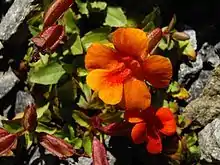Erythranthe nasuta
Erythranthe nasuta is a species of monkeyflower. It was formerly known as Mimulus nasutus.[1][2][3][4]
| Erythranthe nasuta | |
|---|---|
 | |
| Scientific classification | |
| Kingdom: | Plantae |
| Clade: | Tracheophytes |
| Clade: | Angiosperms |
| Clade: | Eudicots |
| Clade: | Asterids |
| Order: | Lamiales |
| Family: | Phrymaceae |
| Genus: | Erythranthe |
| Species: | E. nasuta |
| Binomial name | |
| Erythranthe nasuta | |
| Synonyms | |
|
Mimulus nasutus Greene | |
Erythranthe guttata is pollinated by bees, such as Bombus impatiens. Inbreeding reduces flower quantity and size and pollen quality and quantity. E. guttata also displays a high degree of self-pollination.[5][6] E. nasuta evolved from E. guttata in central California between 200,000 and 500,000 years ago and since then has become primarily a self-pollinator. Other differences have occurred since then, such as genetic code variations and variations in plant morphology.[7][8] E. guttata prefers a wetter habitat than E. nasuta.[9]
References
- Barker, W.R.; Nesom, G.L.; Beardsley, P.M.; Fraga, N.S. (2012), "A taxonomic conspectus of Phrymaceae: A narrowed circumscriptions for Mimulus, new and resurrected genera, and new names and combinations" (PDF), Phytoneuron, 2012–39: 1–60CS1 maint: uses authors parameter (link)
- Beardsley, P. M.; Yen, Alan; Olmstead, R. G. (2003). "AFLP Phylogeny of Mimulus Section Erythranthe and the Evolution of Hummingbird Pollination". Evolution. 57 (6): 1397–1410. doi:10.1554/02-086. JSTOR 3448862.
- Beardsley, P. M.; Olmstead, R. G. (2002). "Redefining Phrymaceae: the placement of Mimulus, tribe Mimuleae, and Phryma". American Journal of Botany. 89 (7): 1093–1102. doi:10.3732/ajb.89.7.1093. JSTOR 4122195. PMID 21665709.
- Beardsley, P. M.; Schoenig, Steve E.; Whittall, Justen B.; Olmstead, Richard G. (2004). "Patterns of Evolution in Western North American Mimulus (Phrymaceae)". American Journal of Botany. 91 (3): 474–4890. doi:10.3732/ajb.91.3.474. JSTOR 4123743. PMID 21653403.
- Carr, David E.; Roulston, T’ai H.; Hart, Haley (2014). "Inbreeding in Mimulus guttatus Reduces Visitation by Bumble Bee Pollinators". PLOS ONE. 9: e101463. doi:10.1371/journal.pone.0101463. PMC 4103763. PMID 25036035.
- Ritland, Kermit (1989). "Correlated Matings in the Partial Selfer Mimulus guttatus" (PDF). Evolution. University of British Columbia. 43 (4): 848–859. doi:10.2307/2409312. Archived from the original (PDF) on 2017-03-04. Retrieved 2017-03-03.
- Brandvain, Yaniv; Kenney, Amanda M.; Flagel, Lex; Coop, Graham; Sweigert, Andrea L. (2014). "Speciation and Introgression between Mimulus nasutus and Mimulus guttatus". PLOS Genetics. 10: e1004410. doi:10.1371/journal.pgen.1004410. PMC 4072524. PMID 24967630.
- Dole, Jefferey A. (1992). "Reproductive Isolation in the M-guttatus-M.Nasutus Complex". The American Midland Naturalist. 100 (2): 269–276. JSTOR 2424826.
- Kiang, Y. T.; Hamrick, J. L. (1978). "Reproductive Assurance Mechanisms in Three Taxa of the Mimulus guttatus Complex (Scrophulariaceae)". American Journal of Botany. 79 (6): 650–659. doi:10.1002/j.1537-2197.1992.tb14607.x. JSTOR 2444881.
This article is issued from Wikipedia. The text is licensed under Creative Commons - Attribution - Sharealike. Additional terms may apply for the media files.